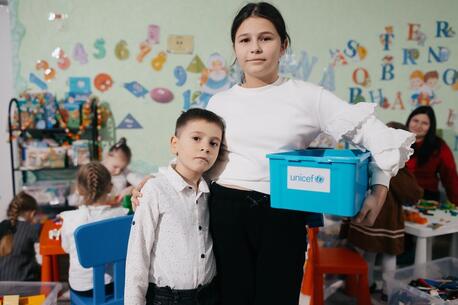Inside Look: How UNICEF Supports Migrant Children in the United States
The many factors shaping UNICEF’s strategy for protecting the rights of all children, regardless of immigration status.
Eitan Peled, Child Migration & Protection Program Manager for UNICEF USA, recently checked in with Rhonda Fleischer, UNICEF Migration Program Specialist, to learn more about how pandemic conditions and a changing policy landscape are shaping UNICEF’s approach to helping migrant children and families stay safe and protected.
Please tell us a little bit about yourself, your professional background and your role at UNICEF.
RHONDA FLEISCHER: I'm a licensed social worker by training. Early on in my career, I worked with runaway and homeless youth, dealing with the child welfare system and working in family-based mental health.
I quickly realized that my passion had a more international focus so that's when I began what has now been a 20-year career helping refugees in the U.S. Until I joined UNICEF a few years ago, I worked with programs largely funded by the U.S. State Department. I’m really proud of the strong tradition the United States has of welcoming refugees.
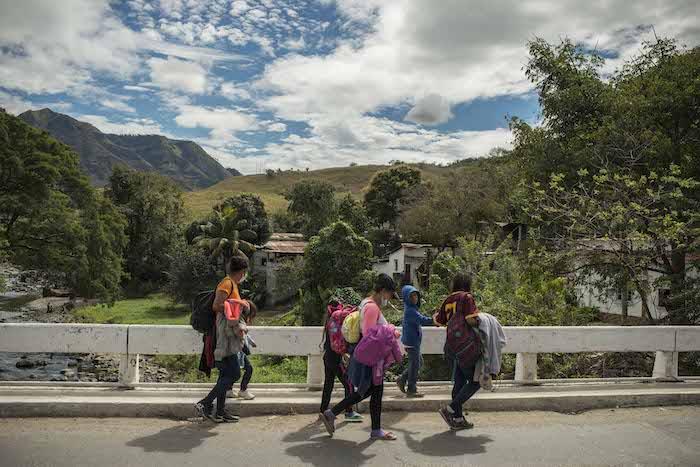
A family from Honduras makes their way into Guatemala, heading north. © UNICEF/UN0401897/Volpe
Today I work out of UNICEF’s New York headquarters as the Program Specialist for Migration, focusing on the protection needs of refugee and migrant children in the United States. I also support the work in Northern Central America and Mexico, taking a route-based approach in the subregion.
Let’s talk about the larger corridor. You mentioned Northern Central America and Mexico — what is the story for so many of these kids before they actually get to the United States?
RHONDA FLEISCHER: Well, we’re talking about some of the most violent places in the world. Violence is a daily reality for children in places like Honduras and Guatemala. They are forcibly recruited into gangs. They’re afraid to go to school. Girls and women are subject to gender-based violence with very little opportunity for justice and protection.
On top of all of that, families have been devastated by natural disasters — hurricanes and floods — in recent years. And now with COVID, conditions are even worse. Domestic violence, child abuse and infanticide have all skyrocketed.
The other thing that's important to mention that's pretty unique to this part of the world is how much this really is a family reunification issue. So many unaccompanied children who seek to come to the United States are really looking to reunite with parents or other close family members that are already living here. The violence, devastating natural disasters, poverty — these are some pretty compelling drivers that are forcing people to leave places they love and that they call home. There’s an impetus to think, ‘Well, my mother is in the U.S., and I’ve been wanting to see her for seven years now.’
So what happens once a child arrives at the U.S. border, and what is UNICEF's role in that process?
RHONDA FLEISCHER: Generally when children or families arrive at the U.S. border, they're detained by Customs and Border Protection. They're supposed to spend no more than 72 hours in detention, and then be released. Families are generally either put into a family detention center or released to one of the many shelters run by community-based organizations along the southern border.
If it's an unaccompanied child, the child is turned over to the care of a shelter within the Office of Refugee Resettlement, which is part of the U.S. Department of Health and Human Services. In that system, the government looks to identify a parent or other family member to whom they could release that child while the child’s immigration proceedings continue.
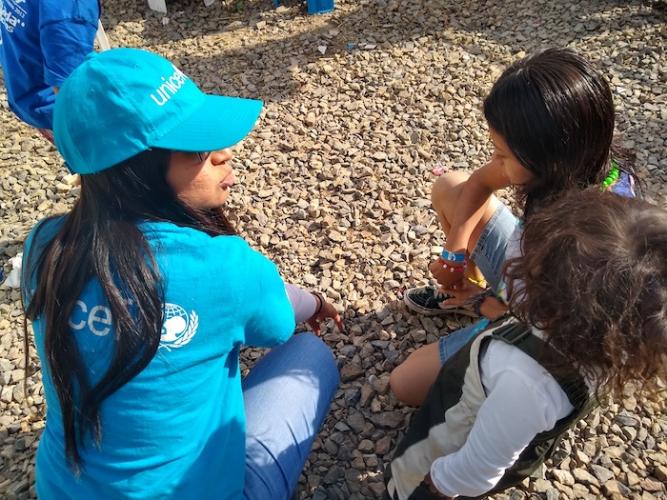
A UNICEF volunteer connects with migrant children at a UNICEF-supported shelter in Tijuana, Baja California state, Mexico. © UNICEF/UN0271781/Kelly
For families, there really hasn't been a robust formal system to date, a formal family case management program or other type of option to support those families to make their way from that point at the border to the communities where they're destined.
There is, however, an amazing, heroic bunch of volunteers and staff working with community-based organizations who have rallied to support families as they make their way into local communities and hopefully have a chance at a fair process in immigration court.
Even before the pandemic, UNICEF was concerned that policy changes had made it very, very difficult for children and families to access the U.S. border, or to seek legal pathways that would allow them to avoid the dangerous journeys to come here. And then in March 2020, more restrictions were put into place that effectively stopped asylum processing at the border for most people — and thousands and thousands of children and families were expelled without due process. Basically since COVID the U.S. has not allowed vulnerable children and families to seek protection, pushing them back into harmful situations.
We are constantly looking at how the overall system could better support migrant and asylum-seeking children ... There's an opportunity now to make real improvements.
That being said, there have been some recent changes that are giving us hope that things are going to get better. The U.S. government announced that certain asylum-seeking families with active asylum cases who have been waiting months, if not years in dangerous situations, on the Mexico side of the border — forced to do so under the Migrant Protection Protocols — can now be registered and cleared for entry. They will have an opportunity to remain in the U.S. during their immigration proceedings. UNICEF is one of the three international organizations working with the U.S. government to operationalize this plan. We're already assisting with the pre-arrival process that kicked off a few weeks ago – focused specifically on complex child protection cases.
We believe there will be more opportunities to work with the U.S. government — to create new legal pathways for migrant children and families. It's UNICEF's mandate to also make sure that all those things happen in a way that puts the best interests of children first, that is child-sensitive and ensures a continuity of care through better coordination among all the entities involved.
Such a complex situation. Can you talk about the dynamic between UNICEF and UNICEF USA, how we work together on this issue?
RHONDA FLEISCHER: Yes. UNICEF and UNICEF USA have a wonderful partnership, a unique partnership. As you know UNICEF is part of the UN, and mandated to uphold children's rights; UNICEF USA is a critical part of that family, an NGO with the same mandate that’s established and embedded in the U.S.
I think together we've been able to accomplish a great deal: speaking to the root causes of forced migration; presenting to elected officials, influencers in Congress; activating campaigns where we ask supporters to call, email, tweet or write letters advocating on behalf of these children, and generally making sure that their voices are heard.
And of course UNICEF USA, like other national committees around the world, also helps generate support for our program interventions in education, child protection, health and other areas that are so critical in this region — and that are so important for addressing the drivers that cause children to flee in the first place.
In particular, UNICEF, with UNICEF USA support, has been stepping up our monitoring of conditions for children along the migratory route, especially in light of some of the more negative policy developments. And we've offered some guidance in terms of child-sensitive border processes — what would it look like to welcome children and families at the border with dignity and a recognition of their legitimate protection concerns? How do you minimize harm to children who've been through so much already?
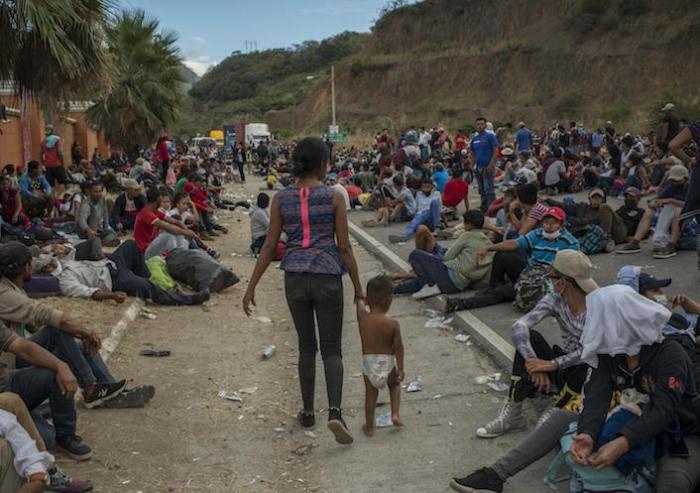
Migrants from Honduras head north to flee violence, poverty and hardship exacerbated by the effects of recent hurricanes. Says UNICEF Migration Program Specialist Rhonda Fleischer: "These are some pretty compelling drivers that are forcing people to leave places they love and that they call home." © UNICEF/UN0401889/Volpe
We have a new initiative, called Building Bridges, to improve how unaccompanied children are received. We've had some convenings, bringing together government representatives from federal, state and local governments, care providers, shelter providers and community-based organizations to really tackle together what's working well and to discuss how to make the system work better for children.
We are also looking at how to end immigration detention, by expanding and scaling family and community-based care options; how to scale services that really ensure that migrant children and families get the essential services they need for their basic well-being, like health care and psychosocial support. And we're trying to facilitate good coordination between services provided at the border and at destination communities. There are some incredible organizations poised and ready to help people meet their basic needs, and to navigate a really complex legal system.
These are the things that are ultimately going to help with getting children and families to show up to their immigration court proceedings. They're going to help ensure that people are on a pathway to safety.
And when it's not in a child's best interest to stay in the United States, we’re also looking at how to best support their safe return to their countries of origin. It’s UNICEF's priority to work with governments across the region and other partners to find ways to facilitate and support cross-border case management, so that if migrant children do need to go back to their countries of origin, they get the support they need for successful reintegration, and to feel safe so they don’t need to make that dangerous journey again.
How does UNICEF prioritize which interventions to do or not do in a case like this?
RHONDA FLEISCHER: UNICEF has put together a global framework for action that sets six priorities for refugee and migrant children, things like ending immigration detention, ensuring access to essential services and family unity. Within this framework we seek to leverage UNICEF expertise and best practices from the work we do around the world. We look to see where we can provide guidance, where we can bring a little attention, where we can provide technical assistance; where we can bring together and help coordinate different actors to uplift the good work that's happening, and help those involved implement good policy and practice. We are constantly looking at how the overall system could better support migrant and asylum-seeking children.
Jeison, 16, photographed in his home in Brentwood, New York. Jeison came to the U.S. from Honduras at the age of 10, traveling as an unaccompanied minor. He says he walked for much of the journey and recalls seeing people hungry and dying — "Nothing I hadn't seen before." Back in Honduras, at age 3, he had witnessed his own father's murder. © UNICEF/UN0373316/Murphy/Principle Pictures
On a more concrete level, we have been coordinating with UNICEF Mexico to improve conditions in the shelters along the U.S.-Mexico border, making sure there is appropriate mental health and psychosocial support available to migrant children and families. That’s part of our ongoing humanitarian response.
In the U.S., many of the groups we work with have large numbers of volunteers working for them — volunteers who are very well meaning, compassionate and dedicated but who may not necessarily have had training in some key approaches. UNICEF provides technical assistance and training, in psychological first aid, for example. We've offered workshops for volunteers and staff to prepare them for the difficult work of receiving children and families and hearing their stories, to help them keep going in this difficult work.
You mentioned technical assistance. Can you give an example of a technical intervention, what that means in practice?
RHONDA FLEISCHER: In 2019, I was visiting one of the shelters in south Texas. A mother and her 12-year-old daughter had just arrived. They had been traveling with a group of maybe six other women, and the group had hired a coyote, or guide to take them on their journey to the United States. The group was kidnapped twice. The first time they were held in a house, and some of the women were raped. The 12-year-old wasn’t raped, but she had witnessed everything. They escaped, and continued on, but then their guide was murdered, shot while driving the car they were all riding in.
Somehow the group still managed to make it to the U.S. border. The mother and her daughter spent a few days in a Customs and Border Protection detention center and then were released to the border shelter. It was at the shelter where they said they could finally take a deep breath, eat a nice meal, feel a semblance of safety.
The girl was not coping well, however. She was in severe distress, crying all the time, acting aggressively; biting and scratching her mother but also crying and clinging to her. There was a lot of compassion among those working at the shelter, and the volunteers were incredibly skilled in some ways, but they were really at a loss for how to help this girl.
UNICEF was able to facilitate a referral to a mobile mental health team so the girl could be assessed by mental health professionals who would come and speak to her and her mother. To help the mother understand that this is a natural and normal reaction. To provide calm.
Connecting migrant children and families with mental health services and other support
And then the mother and her daughter were able to take that next step — take a bus to their destination, further into the United States. And with UNICEF’s help, the volunteers working at the shelter were also able to provide a referral for family support and mental health services and case management in the town where they were headed.
Ultimately, what we did in south Texas and what we continue to do is provide training for staff and volunteers specifically on psychological first aid for migrant children and families. They learn to provide basic psychosocial support to basically calm children and families who are in immediate distress. They also learn the limits of that role. If you're not a mental health specialist, that's not the time to dig into stories of trauma and persecution, right? So it's about attending to the distress when it's most critical, and making sure there are some good referral processes in place for bringing in mental health specialists when the need arises.
What a harrowing and difficult experience it must be for so many of these families. It seems particularly important that UNICEF works in partnership with these organizations on the ground, and in partnership with governments.
RHONDA FLEISCHER: Absolutely. There is an exciting effort going on in Mexico now with care reform, where UNICEF is actively helping the government create community-based alternatives to detention, like placement with foster families and in small-group shelters. We are sharing some of those good practices in the U.S.
There are organizations that are really fantastic, parts of the system that the U.S. government already operates that provide really good care for children. So what could that look like if we were to scale that up? Or scale up services for unaccompanied children once they're released from the Office of Refugee Resettlement? We’re looking into all of this. UNICEF acts as a convener, bringing together the people who really care about putting children's best interests first and sharing what we've learned in our own experiences working with governments all over the world.
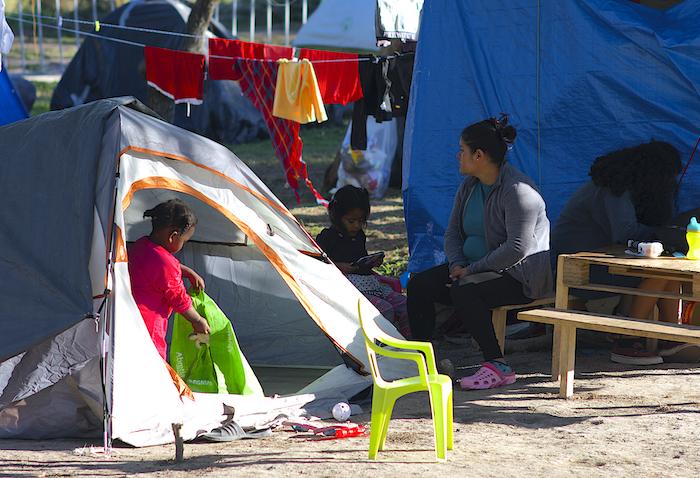
Since 2019, asylum seekers have been forced to wait in Mexico under the Migrant Protection Protocols, but UNICEF sees new opportunities ahead to create legal pathways to safety for these families. In the meantime, thousands are staying in camps like the one pictured above in Matamoros, where UNICEF Mexico and partners are providing psychosocial support and other services. © UNICEF/UNI285120/Amador
What is needed to realize UNICEF’s vision that children are children, regardless of where they are from or their immigration status? Is it money? Political will? A new narrative?
RHONDA FLEISCHER: I think there's real interest in doing this right. Conditions in the region are dire, yes, but at the same time there is this incredible window of opportunity to make some real improvements to the larger system that’s in place right now, within the United States and across the subregion.
I think there's never been a greater time for people who care to step up as advocates; to reach out to decision makers, to lawmakers, and to have conversations at home about putting the needs of refugee and migrant children first. We can do this. We can protect our borders and process asylum cases. We can do this while still accounting for security risks and public health considerations. We’ve been doing it for decades. The U.S. has been a champion in the refugee world, a champion for children's rights. Let's build on that tradition.
The current pandemic must still be complicating things...
RHONDA FLEISCHER: Yes. We’ve had to bring stakeholders together remotely to discuss reception care and services for unaccompanied children. Many of these convenings had to go virtual. We’ve had to pivot and do mental health trainings remotely too. We’ve developed a train-the-trainer program to help organizations train their own volunteers in psychological first aid. And that helps ensure the training continues even when UNICEF can’t be there.
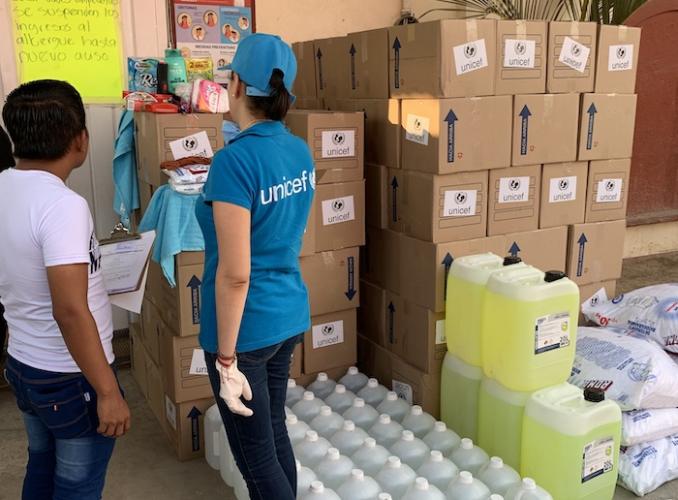
UNICEF staff prepares to deliver hygiene supplies to migrant families from Central America sheltering in Tapachula, Mexico. © UNICEF/UNI322145
We are collaborating with the Migration Policy Institute for a series of remote convenings on how to support unaccompanied children's transition to communities once they are released from federal custody — how to help families who come into the U.S. access basic services, get their kids into schools and find legal help — all the challenges these families face navigating daily life in a new country and their own legal cases. All of that has been heightened due to the pandemic.
What keeps you going on a personal level?
RHONDA FLEISCHER: For me, it’s getting to know these families. I'm constantly inspired by their resilience, their determination. I’m not saying everybody's perfect and makes all the right decisions because none of us do. But they are driven by the most primal instinct: to do whatever it takes to keep their children safe and well, to make sure they can get an education, the same things we want for our own children.
We hope this is just a beginning, that there are many opportunities before us to support children and families in a way that upholds their rights and supports them as we would want our own children supported.
Help UNICEF keep working to keep migrant children safe and protected — wherever they are.
Top photo: Jennifer, 15, coloring with daughter Scarlett, migrated from Guatemala to the United States when she was 13. She made the trip with her sisters, eventually reuniting with their mother in Hempstead, N.Y., after being apart from her for five years. © UNICEF/UN0373320/Murphy/Principle Pictures


